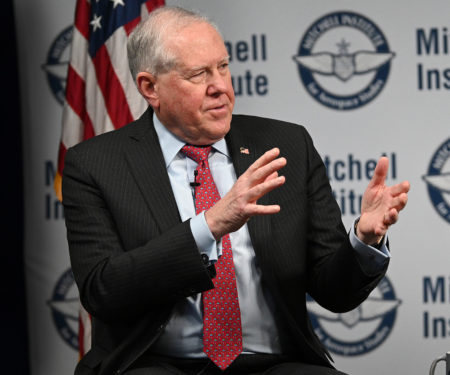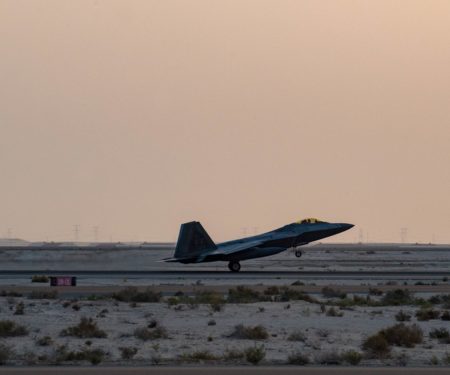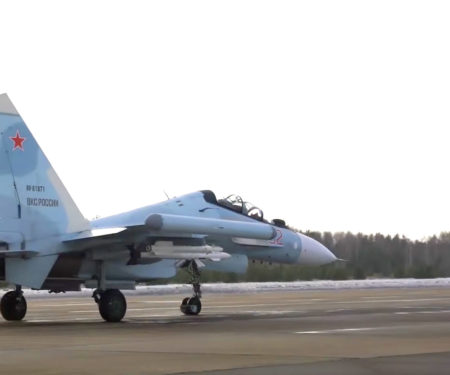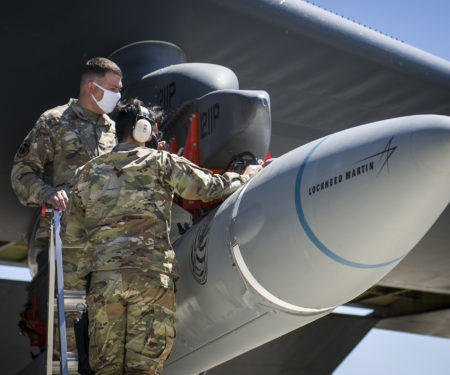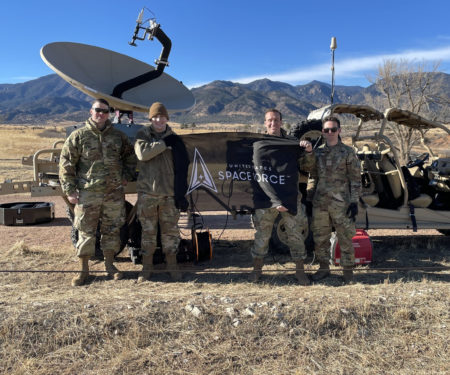Radar Sweep
The First Shots in a Ukraine Conflict May Be in Space
This past November, the Russian Federation destroyed one of its own Soviet-era satellites with a missile, sending thousands of scraps of shrapnel hurtling through space, a cloud of debris that threatened other orbiting satellites including those belonging to the U.S. The missile launch could be a preamble, a reminder that, as the threat of a Russian invasion looms in Ukraine and modern warfare increasingly relies on satellites for intelligence and communications, space could be one of the first battlefields, according to experts.
How Autonomous Wingmen Will Help Fighter Pilots in the Next War
Imagine that sometime in the next decade, a long-feared war with China has erupted. In a bid to destroy Chinese defenses and break through to its airspace, the U.S. Air Force sends its advanced fighter jets and bombers into the most hostile territory it’s faced in decades. But this mission is different from those of the past. Swarming alongside each manned aircraft is a handful of small drone wingmen, operating with minimal direction from the accompanying pilot. They scout ahead to map out targets, jam enemy signals using electronic warfare capabilities, and launch their own missiles to carry out airstrikes and destroy targets—multiplying the effect a single pilot can have in battle.
OPINION: Why the Space Force Merits Respect and an Expanded Mission
Retired Air Force Gen. Kevin Chilton has proposed that the Space Force be empowered to do more to defend America’s space assets and to place those of its enemies at risk. He also proposes that the new service branch be tasked with support from other branches of the military, mainly by providing real-time, near-instantaneous reconnaissance of the battle spaces that the Army, Navy, Air Force, and Marine Corps operate in. Chilton, who was not only a NASA astronaut but also commanded the Air Force’s Space Command, suggests that Space Force Guardians need the same sort of training that members of the other service branches engage in. Chilton’s suggestions would transform the Space Force from an esoteric organization that many people have never heard of into a true, war-fighting military service branch.
AFA Announces National Finalists for CyberPatriot XIV
The Air Force Association’s CyberPatriot National Youth Cyber Education program announced the 28 teams that will compete at the CyberPatriot XIV National Finals Competition from March 18 to 20, 2022. From the initial field of 5,254 teams that began the competition in October 2021, only 12 Open Division, 13 All Service Division, and three Middle School Division teams advanced through all four highly competitive online qualifying rounds to earn the distinction of national finalist.
Missile Warning & Defense
Defending against missile threats launched in, at, or through space has never been more challenging—or important. Learn more on Air Force Magazine’s Missile Warning & Defense page.
Airman Eliminated After Third Women’s Skeleton Heat at Beijing Olympics
American Olympian Kelly Curtis finished 21st in women’s skeleton at the Winter Games in Beijing, narrowly missing the cut to compete for a medal in the final heat. Curtis, an Airman First Class and first-time Olympian, recorded a combined time of 3:09.23 across three rounds on the mile-long ice track—0.38 seconds behind her nearest opponent and 3.24 seconds behind the third heat’s first-place finisher, German Hannah Neise. Curtis needed to land in the top 20 on Feb. 12 to qualify for the fourth heat later that day but finished one spot short.
The Iraqi Air Force: Perpetually Between East And West
From its foundation in 1931 until today, Iraq has gone through several periods of procuring its aircraft from both East and West. In the 1950s, Iraq acquired its first-ever fighter jets when Britain sold it de Havilland Vampires, de Havilland DH 112 Venoms, and Hawker Hunters. However, following the 1958 coup in Iraq that ended the monarchy, Baghdad drifted closer to the Soviet Union. As a result, it first began acquiring MiG-17s, followed by MiG-19s and MiG-21s. As a result, by the 1960s, as military aviation historian Tom Cooper pointed out, Iraq “had a very mixed fleet of fighter jets, consisting of Vampires, Venoms, Hunters, MiG-17s, MiG-19s, and MiG-21s.”
Grand Forks Air Force Base Flexes With Swift Transition from Operation Allies Refuge to Operation Allies Welcome
After providing critical high-altitude overwatch and intelligence support for the largest airlift in American history, within hours, the 319th Reconnaissance Wing pivoted to worldwide relocation support. In the first 48 hours of tasking notifications, 11 Airmen were in place and assisting refugees. From security and administration to logistics and linguistics, more than 35 Grand Forks Airmen from over a dozen career fields deployed to assist with Operation Allies Welcome, the majority aiding Holloman Air Force Base, N.M., and Joint Base McGuire-Dix-Lakehurst, N.J.
DOD Needs to Improve How It Tests Cyber Weapons Architecture, Weapons Tester Says
The way U.S. Cyber Command procures and tests new capabilities for cyber operations lacks a test and evaluation strategy as well as the proper authority and resources to manage new tools, which the Pentagon’s weapons tester has said could result in fielding capabilities without demonstrating or understanding their effectiveness, suitability, or survivability.
OPINION: It’s Not Just 5G: China’s Telecom Strategy Needs to be Countered in Space
In Washington the consensus is well set that China’s strategy for 5G has created a telecommunications nightmare for American interests. What is less clear is how to proceed. In this op-ed, Lt. Col. Gabe Arrington, a national defense fellow at the Center for a New American Security and Seminar XXI fellow at the Massachusetts Institute of Technology, suggests that the Biden administration needs to look up to space to provide a counter for China’s telecommunications plan.
OPINION: The Indo-Pacific Strategy Needs Indo-Specifics
“What is objectionable is not so much what is in the strategy than what is not in it. Namely, it repeatedly skirts around the defining challenge of our time: China’s rise. The strategy is long on vague, anodyne pledges: “We will foster security ties among allies” and “meet civilian security challenges” and “build connections.” But it and the fact sheet are worryingly short on concrete proposals and creative ideas for meeting the China challenge. Indeed, Biden’s strategy says virtually nothing about the military competition with China or the steps necessary to roll back its intimidation of allies and partners,” writes Jeff M. Smith, a research fellow in The Heritage Foundation’s Asian Studies Center and the editor and contributing author of “Asia’s Quest for Balance: China’s Rise and Balancing in the Indo-Pacific.”
How an Air Force Spy Plane Pilot Saved a Civilian Aviator in Distress from 70,000 Feet
You might not think a 66-year-old spy plane that flies top secret missions in faraway places would also double as a rescue plane in a pinch, but that’s exactly what happened earlier this month high above northern California. On Feb. 8, an Air Force pilot flying the U-2 Dragon Lady, an all-black spy plane that first entered service in 1956, doubled as a flying relay station between air traffic control and a civilian pilot having engine trouble. After about 30 minutes, the civilian came to a safe landing, all because the U-2 had the altitude to get messages to and from the imperiled civilian aircraft.
